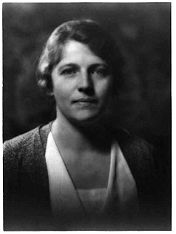Pearl S Buck
Pearl Sydenstricker Buck, most familiarly known as Pearl S. Buck (birth name Pearl Comfort Sydenstricker) (June 26, 1892 – March 6, 1973), was a prolific American writer who won a Nobel Prize in Literature (1938) and a Pulitzer Prize.
Pearl was born in Hillsboro, West Virginia, USA to Caroline Stulting (1857-1921) and Absalom Sydenstricker, a Southern Presbyterian missionary. The family was sent to Zhenjiang, China in 1892 when Pearl was 3 months old. She was raised in China and was tutored by a Confucian scholar named Mr. Kung. She was taught English as a second language by her mother and tutor.
The Boxer Rebellion (an uprising in China during 1899-1901) greatly affected Pearl Buck and her family. Pearl wrote that during this time, “…her eight-year-old childhood … split apart.” Her Chinese friends deserted her and her family, and there were not as many Western visitors as there once were. “The streets [of China] were alive with rumors - many … based on fact- of brutality to missionaries …” Pearl’s father was a missionary, so Buck’s mother, her little sister, and herself were “…evacuated to the relative safety of Shanghai, where they spent nearly a year as refugees…” (The Good Earth, Introduction) In July 1901, Buck and her family sailed to San Francisco. Not until the following year did the Sydenstrickers return to China.
From 1910 to 1933, she left China briefly either to further her education or to escape from political and military upheaval in China. On May 13, 1917, she married an agricultural economist missionary, John Lossing Buck. The family mainly lived in Nanjing, where Pearl and John both had teaching posts at the University of Nanking.
From about 1933 she began her writing career in the USA. In 1935, she bought a sixty-acre homestead she called Green Hills Farm and moved into the one hundred year-old farmhouse on the property with her second husband and their family of six children. Green Hills Farm is where Pearl spent thirty-eight years of her life, raising her family, writing, pursuing humanitarian interests, and gardening.
Pearl was an extremely passionate activist for human rights. In 1949, outraged that existing adoption services considered Asian and mixed-race children unadoptable, Pearl established Welcome House, Inc., the first international, interracial adoption agency. In the nearly five decades of its work, Welcome House has assisted in the placement of more than five thousand children.
In 1964, to provide support for Asian-American children who were not eligible for adoption; she also established the Pearl S. Buck Foundation, which provides sponsorship funding for thousands of children in half a dozen Asian countries. When establishing the Opportunity House Foundation to support child sponsorship programs in Asia, Pearl said, "The purpose...is to publicize and eliminate injustices and prejudices suffered by children, who, because of their birth, are not permitted to enjoy the educational, social, economic and civil privileges normally accorded to children."
In her writings, she dealt with many topics including women's rights, emotions (in general), Asian cultures, immigration, adoption, and conflicts that many people go through in life.
Pearl S. Buck died of lung cancer on March 6, 1973 in Danby, Vermont and was interred in Green Hills Farm in Perkasie.

